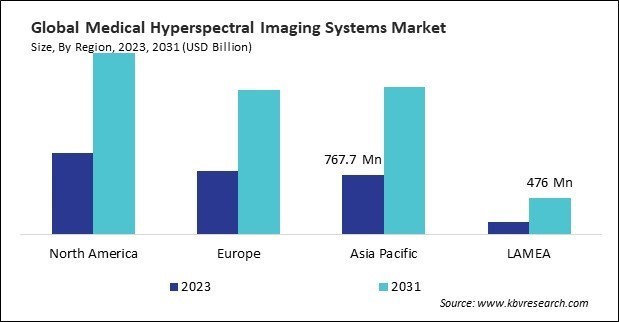According to a new report, published by KBV research, The Global Medical Hyperspectral Imaging Systems Market size is expected to reach $6.7 billion by 2031, rising at a market growth of 11.5% CAGR during the forecast period.
Medical hyperspectral imaging systems are increasingly used in surgical settings. By providing real-time, high-resolution images of tissues, these systems can help surgeons navigate complex anatomical structures with greater precision, leading to better patient outcomes. Pharmaceutical companies also recognize hyperspectral imaging systems' potential for drug development and research. These systems can be used to study the distribution and pharmacokinetics of drugs in tissues, helping to optimize drug delivery strategies and improve the efficacy of treatments.

The Hyperspectral Camera segment is leading the Global Medical Hyperspectral Imaging Systems Market by Product in 2023; thereby, achieving a market value of $4.9 Billion by 2031. Hyperspectral cameras can capture images at hundreds of narrow spectral bands, allowing for detailed analysis of the spectral characteristics of objects or scenes. In applications requiring precise material identification and characterization, such as agriculture for disease detection and crop monitoring, this capability is especially valuable. The demand for hyperspectral cameras is propelled by the need for advanced imaging capabilities for a wide range of applications and the increasing affordability and accessibility of this technology.
The Push Broom segment is experiencing a CAGR of 11.7% during (2024 - 2031). The demand for push broom technology is driven by its high spectral and spatial resolution, flexibility, versatility, and potential for dynamic imaging. Push broom technology offers high spectral resolution, allowing for detailed tissue composition, perfusion, and oxygenation levels analysis. This high resolution is particularly valuable in medical applications where subtle differences in tissue characteristics can have diagnostic significance.
The Medical Diagnostics segment is generating the maximum revenue in the Global Medical Hyperspectral Imaging Systems Market by Application in 2023; thereby, achieving a market value of $2.9 Billion by 2031. Medical hyperspectral imaging systems used in medical diagnostics are propelled by their ability to provide detailed and objective information about tissue characteristics, their non-invasive nature, and their potential to improve patient outcomes through early detection and precise surgical guidance. Hyperspectral imaging is expected to play an increasingly important role in medical diagnostics and research as technology advances.
The Research & Academic Institutes segment is showcasing a CAGR of 12.5% during (2024 - 2031). Hyperspectral imaging allows researchers to study biological tissues and processes at a molecular level, providing valuable insights into disease mechanisms, treatment responses, and tissue characterization. This advanced imaging capability is particularly valuable in research areas such as cancer biology, neuroscience, and regenerative medicine. This is valuable for accelerating the development of new drugs and improving existing therapies.
Full Report: https://www.kbvresearch.com/medical-hyperspectral-imaging-systems-market/
The North America region dominated the Global Medical Hyperspectral Imaging Systems Market by Region in 2023, and would continue to be a dominant market till 2031; thereby, achieving a market value of $2.4 Billion by 2031. The Europe region is anticipated to grow a CAGR of 11.1% during (2024 - 2031). Additionally, The Asia Pacific region would witness a CAGR of 12.3% during (2024 - 2031).
By Product
By Technology
By Application
By End Use
By Geography
 Unique Offerings
Unique Offerings